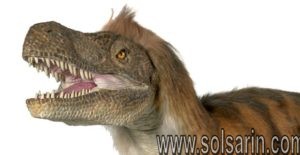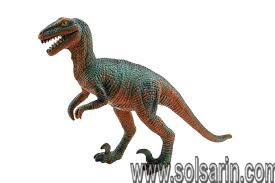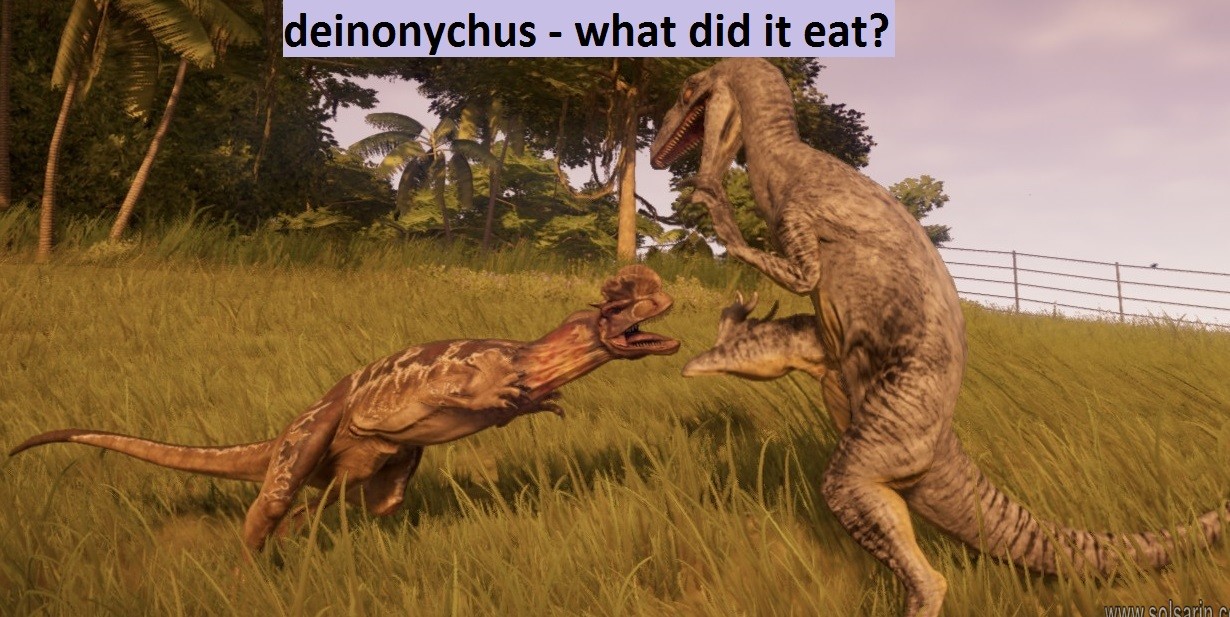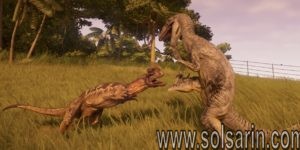deinonychus – what did it eat?
Hello dear friends, thank you for choosing us. In this post on the solsarin site, we will talk about “deinonychus – what did it eat?”.
Stay with us.
Thanks for your support.


Deinonychus, (genus Deinonychus), long-clawed carnivorous dinosaurs that flourished in western North America during the Early Cretaceous Period (145.5 million to 99.6 million years ago). A member of the dromaeosaur group, Deinonychus was bipedal, walking on two legs, as did all theropod dinosaurs. Its principal killing devices were large sicklelike talons 13 cm (5 inches) long on the second toe of each foot. The slender, outstretched tail was enclosed in bundles of bony rods. These extensions of the tail vertebrae were ideal for helping the animal maintain balance as it ran or attacked prey.
Deinonychus was the model for the “raptor” dinosaurs of the motion picture Jurassic Park (1993). The name raptor has come to apply to dromaeosaurs in general as a contraction for Velociraptor, a genus of dromaeosaur that was considerably smaller than Deinonychus. However, the term raptor (from the Greek word for “seize” or “grab”) is more correctly applied to birds such as hawks and eagles, which grasp prey with their talons. Deinonynchus measured about 2.5 metres (8 feet) or perhaps more in length and weighed 45–68 kg (100–150 pounds). It was evidently a fast, agile predator whose large brain enabled it to perform relatively complex movements during the chase and kill.
Dromaeosaurs and troodontids are the closest known relatives of Archaeopteryx and existing birds. These dinosaurs share with birds a number of features, including unusually long arms and hands and a wrist that is able to flex sideways. Such adaptations apparently helped these dinosaurs to grasp prey and later enabled birds to generate an effective flight stroke.
Deinonychus Facts
- Species Type: Deinonychus antirrhopus
- Type of Dinosaur: Dromaeosaurid theropod
- Period: Early Cretaceous
- Diet: Meat (carnivorous)
- Length: Up to 11 feet
- Weight: Up to 220 pounds
- First Discovered: 1931
21 Deinonychus Facts for Kids
-
- The Deinonychus was discovered by American paleontologist Barnum (Mr. Bones) Brown in 1931.
-
- The Deinonychus was first discovered in the Cloverly Formation in North America.
- The Deinonychus got its scientific name Deinonychus antirrhopus in 1969, from John Ostrom.
- The name Deinonychus means: “Terrible Claw”.
- The name Deinonychus is pronounced: “dye-NON-ik-us”.
- The Deinonychus was part of a group of dinosaurs known as dromaeosaurid theropods.
- Dromaeosaurids were a group of dinosaurs that had features, which means Deinonychus had feathers.
- Deinonychus lived during the Early Cretaceous Period, between 115 and 108 million years ago.
- Paleontologists have confirmed recovered Deinonychus specimens in the Cloverly Formation, Cedar Mountain Formation and Antlers Formation.
-
- Paleontologists only recognize one species of Deinonychus and that is Deinonychus antirrhopus.
- The type specimen for the Deinonychus is specimen YPM 5205.
- The Deinonychus was a carnivore that ate meat.
- Estimates put the length of a Deinonychus up to 11 feet.
- Estimates put the weight of a Deinonychus up to 220 pounds.
- The Deinonychus is in the same family as the Velociraptor.
- In 2015, a research paper suggested that young Deinonychus might have been capable of some form of flight.
- The belief that birds are descendants of dinosaurs was help supported by studies done on the Deinonychus.
Type of dinosaur:
- small theropod
- Length:
- 3.0m
- Weight:
- 75kg
- Diet:
- carnivorous
- Teeth:
- backward-curving
- Food:
- vertebrates, plant-eating dinosaurs
- How it moved:
- on 2 legs
- When it lived:
- Early Cretaceous, 120-110 million years ago
- Found in:
- USA
-


deinonychus – what did it eat?
Deinonychus could hold onto its prey with fearsome front claws. One huge claw on each foot swivelled – a kick would rip prey apart. When not in use the claw was held out of the way to keep it sharp. Deinonychus may have hunted Tenontosaurus.
© Andrey Atuchin
Taxonomic details
- Taxonomy:
- Dinosauria, Saurischia, Theropoda, Neotheropoda, Tetanurae, Avetheropoda, Coelurosauria, Tyrannoraptora, Maniraptoriformes, Maniraptora, Paraves, Eumaniraptora, Dromaeosauridae
- Named by:
- Ostrom (1969)
- Type species:
- antirrhopus
-
You say “Velociraptor,” I say “Deinonychus”
Fifteen years ago, the blockbuster film Jurassic Park introduced audiences to a brand new kind of killer dinosaur. (Michael Crichton, the author of the source novel and screenwriter of the film, passed away on Wednesday)
Giant meat-eaters like Allosaurus and Tyrannosaurus were familiar to everyone, but few people knew about the fleet-footed terrors called “raptors” by the film’s protagonists. Armed with a lethal killing claw on each foot, large grasping hands, and a startling degree of intelligence, the pack of Velociraptor in Jurassic Park were every bit as terrifying as the gargantuan Tyrannosaurus.In paleontology, just like any other biological science, scientific names are often in a state of flux. Sometimes the same dinosaur species receives several different names from different scientists, at which point the first name to appear gets priority. Other times dinosaur species may get names that have already been used for other animals and they need to receive a new name as to avoid confusion.
How tall is a Deinonychus?
Based on the few fully mature specimens, Deinonychus could reach 3.4 meters (11 ft) in length, with a skull length of 410 millimeters (16 in), a hip height of 0.87 meters (2.9 ft) and a weight of 73 kg (161 lb), though there is a higher estimate of 100 kg .

deinonychus – what did it eat? How big were Deinonychus in real life?
Deinonynchus measured about 2.5 metres (8 feet) or perhaps more in length and weighed 45–68 kg (100–150 pounds). It was evidently a fast, agile predator whose large brain enabled it to perform relatively complex movements during the chase and kill.Is Utahraptor bigger than Deinonychus?
These elements have huge proportions compared to other dromaeosaurids, suggesting an animal about twice the length of Deinonychus or, surpassing it in a 100%. Like other dromaeosaurids, Utahraptor had large curved claws on their second toes
Velociraptor
Velociraptor, (genus Velociraptor), sickle-clawed dinosaur that flourished in central and eastern Asia during the Late Cretaceous Period (99 million to 65 million years ago). It is closely related to the North American Deinonychus of the Early Cretaceous in that both reptiles were dromaeosaurs. Both possessed an unusually large claw on each foot, as well as ossified tendon reinforcements in the tail that enabled them to maintain balance while striking and slashing at prey with one foot upraised. Velociraptor was smaller than Deinonychus, reaching a length of only 1.8 metres (6 feet) and perhaps weighing no more than 45 kg (100 pounds). Velociraptor appears to have been a swift, agile predator of small herbivores.
The Editors of Encyclopaedia BritannicaThis article was most recently revised and updated by Adam Augustyn.
archosaur
archosaur, (subclass Archosauria), any of various reptiles, including all crocodiles and birds and all descendants of their most recent common ancestor. Archosaurs (“ruling reptiles”) are members of a subclass that also includes the dinosaurs, the pterosaurs (flying reptiles), and several groups of extinct forms, mostly from the Triassic Period (251 million to 200 million years ago).
theropod
theropod, any member of the dinosaur subgroup Theropoda, which includes all the flesh-eating dinosaurs. Theropods were the most diverse group of saurischian (“lizard-hipped”) dinosaurs, ranging from the crow-sized Microraptor to the huge Tyrannosaurus rex, which weighed six tons or more.
Unlike the sauropod saurischians, all the theropods were obligate bipeds; that is, their hind legs provided support and locomotion while the short forelimbs and mobile hands were probably adapted for grasping and tearing prey. Despite the group’s name, which means “beast (i.e., mammal) foot,” theropod feet usually resembled those of birds. Birds are descended from one lineage of small theropods and therefore are members of Theropoda.
fossil
fossil, remnant, impression, or trace of an animal or plant of a past geologic age that has been preserved in Earth’s crust. The complex of data recorded in fossils worldwide—known as the fossil record—is the primary source of information about the history of life on Earth.
Only a small fraction of ancient organisms are preserved as fossils, and usually only organisms that have a solid and resistant skeleton are readily preserved. Most major groups of invertebrate animals have a calcareous skeleton or shell (e.g., corals, mollusks, brachiopods, bryozoans). Other forms have shells of calcium phosphate (which also occurs in the bones of vertebrates), or silicon dioxide. A shell or bone that is buried quickly after deposition may retain these organic tissues, though they become petrified (converted to a stony substance) over time. Unaltered hard parts, such as the shells of clams or brachiopods, are relatively common in sedimentary rocks, some of great age.
saurischian
saurischian, any member of one of the two major lineages of dinosaurs, including birds and all dinosaurs more closely related to birds than to Triceratops. In 1888 paleontologist Harry G. Seeley, a former student of Richard Owen, separated dinosaurs into two groups based primarily on the form of the pelvis (though he also considered features of the skull and neck vertebrae). One group had hip bones arranged like those of typical reptiles, in which the pubis points down and forward; he named this group Saurischia (“lizard-hipped” or “reptile-hipped”).
dromaeosaur
dromaeosaur, (family Dromaeosauridae), any of a group of small to medium-sized carnivorous dinosaurs that flourished in Asia and North America during the Cretaceous Period (145.5 million to 65.5 million years ago). Agile, lightly built, and fast-running, these theropods were among the most effective predators of their time.
All dromaeosaurs were bipedal, and the second toe of each foot was extremely flexible and bore a specialized killing claw, or talon, that was not used in walking. Instead, it was always held off the ground because it was much larger and was jointed differently from the other claws. The largest killing claw belonged to Deinonychus and measured up to 13 cm (5 inches) in length.





